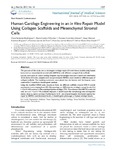Human cartilage engineering in an in vitro repair model using collagen scaffolds and mesenchymal stromal cells

View/
Use this link to cite
http://hdl.handle.net/2183/19766
Except where otherwise noted, this item's license is described as Creative Commond Attribution-NonCommercial 4.0 International Licence (CC-BY-NC 4.0)
Collections
- Investigación (FCS) [1293]
Metadata
Show full item recordTitle
Human cartilage engineering in an in vitro repair model using collagen scaffolds and mesenchymal stromal cellsAuthor(s)
Date
2017-09-28Citation
Sanjurjo-Rodríguez C, Castro-Viñuelas R, Hermida-Gómez T, Fuentes-Boquete IM, de Toro FJ, Blanco FJ, Díaz-Prado SM. Human cartilage engineering in an in vitro repair model using collagen scaffolds and mesenchymal stromal cells. Int J Med Sci. 2017 Sep 28;14(12):1257-1262.
Abstract
[Abstract] The purpose of this study was to investigate cartilage repair of in vitro lesion models using human bone marrow mesenchymal stromal cells (hBMSCs) with different collagen (Col) scaffolds.
Lesions were made in human cartilage biopsies. Injured samples were pre-treated with interleukin 1β (IL1β) for 24 h; also, samples were not pre-treated. hBMSCs were seeded on different types of collagen scaffolds. The resulting constructs were placed into the lesions, and the biopsies were cultured for 2 months in chondrogenic medium.
Using the modified ICRSII scale, neotissues from the different scaffolds showed ICRS II overall assessment scores ranging from 50% (fibrocartilage) to 100% (hyaline cartilage), except for the Col I +Col II +HS constructs (fibrocartilage/hyaline cartilage, 73%). Data showed that hBMSCs cultured only on Col I +Col II +HS scaffolds displayed a chondrocyte-like morphology and cartilage-like matrix close to native cartilage. Furthermore, IL1β pre-treated biopsies decreased capacity for repair by hBMSCs and decreased levels of chondrogenic phenotype of human cartilage lesions.
Keywords
Regenerative medicine
Tissue engineering
Hyaline cartilage
Tissue scaffolds
Mesenchymal stromal cells
Osteoarthritis
Tissue engineering
Hyaline cartilage
Tissue scaffolds
Mesenchymal stromal cells
Osteoarthritis
Editor version
Rights
Creative Commond Attribution-NonCommercial 4.0 International Licence (CC-BY-NC 4.0)
ISSN
1449-1907






